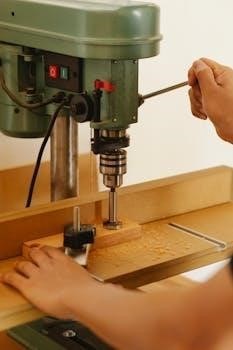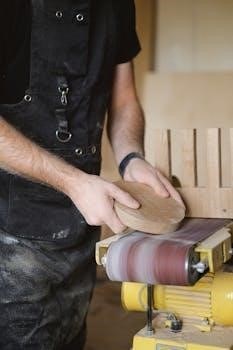Manual CNC Machine⁚ An Overview
While the term “manual CNC machine” might seem contradictory, it often refers to a machine tool where the operator directly controls movements, unlike fully automated CNC systems. However, these machines can be upgraded with numerical control capabilities.
What is a Manual CNC Machine?
A manual CNC machine, at its core, is a machine tool operated primarily by human input. Unlike fully automated CNC machines, where movements are dictated by pre-programmed instructions, a manual CNC machine requires the operator to physically control the cutting tool’s motion through handwheels or levers. However, it’s crucial to clarify that some manual machines can be retrofitted with basic CNC capabilities, often in the form of digital readouts (DROs) for precise measurement, or rudimentary numerical controls for assisting in specific tasks. The focus remains on the operator’s control and skill rather than relying on fully automated processes. This contrasts with a traditional CNC machine, where the computer dictates all movements. The operator is still crucial, but their role shifts to monitoring and programming rather than manual control.
Key Differences Between Manual and CNC Machines
The core difference between manual and CNC machines lies in their operational control. Manual machines rely entirely on the operator’s physical interaction, using handwheels and levers to guide the cutting tool. This demands a high level of operator skill and experience. CNC machines, on the other hand, utilize computer programs to control the tool’s movements, allowing for automated processes. Manual machines offer direct, hands-on control, allowing for adjustments during the machining process but are typically slower and less precise. CNC machines, while requiring programming, provide much higher precision, repeatability and can produce complex parts. The initial setup and programming of a CNC machine can be more complex than the direct operation of a manual machine. Manual machines are also more versatile, while CNC machines are optimized for specific tasks.

Advantages of Manual Machining
Manual machining boasts a lower initial investment, making it accessible for smaller shops. It also offers the flexibility of direct machining without the need for programming, allowing for immediate adjustments.
Lower Initial Investment Costs
One of the most significant advantages of manual machining is the relatively lower initial investment costs compared to CNC machines. Manual machines are typically more affordable to purchase, making them a viable option for small businesses, start-ups, and educational institutions with limited budgets. The lower price tag reduces the financial barrier to entry, allowing a wider range of users to acquire machining capabilities. This also means that a smaller initial outlay is needed to begin operations. The reduced price helps these smaller companies to compete with larger more established businesses. This affordability is a crucial factor for those looking to start machining without a large capital investment.
Direct Machining without Programming
Manual machining offers the distinct advantage of direct machining, eliminating the need for complex programming. This hands-on approach allows machinists to control the cutting process directly, adjusting feeds, speeds, and depth of cut in real-time. This direct interaction makes it easier to make quick changes and adjustments during the machining process. This feature is particularly useful for one-off jobs, prototypes, or projects that require immediate adjustments. The machinist’s skill and experience become crucial, allowing for a more intuitive approach to machining. This allows the operator to work on parts immediately.

Disadvantages of Manual Machining
Despite its benefits, manual machining has limitations, including lower precision and accuracy compared to CNC. It also tends to have slower production speeds, impacting overall efficiency, particularly for large runs.
Lower Precision and Accuracy
Manual machining relies heavily on the operator’s skill, leading to variations in precision and accuracy. Achieving microscopic-level accuracy, common with CNC machines, is virtually impossible with manual methods. The results are often inconsistent due to human factors, such as slight variations in hand movements, leading to less repeatable outcomes. This can be a significant issue when producing parts that require very high levels of consistency and tight tolerances. Manual machining also faces limitations in maintaining consistency across large production runs, where achieving identical parts is a challenge. The dependence on manual control leads to a higher chance of dimensional inaccuracies compared to the precise control offered by computer-driven systems.
Slower Production Speeds
Manual machining is inherently slower compared to automated CNC processes. This is primarily due to the operator’s direct involvement in every step of the machining process, including material handling, tool changes, and executing each cut. The need for manual adjustments and careful observation for each part significantly reduces production speeds. Unlike CNC machines that can operate continuously and at much higher speeds, manual machines require frequent stops and operator intervention. The time taken to complete each part is longer, which results in a lower overall production output. This slower pace can also impact the turnaround time, making manual machining less ideal for large volume production.

Advantages of CNC Machining over Manual
CNC machining offers superior precision and repeatability, increased production efficiency, and the ability to produce complex designs, making it advantageous over manual methods for many applications.
Higher Precision and Repeatability
One of the most significant advantages of CNC machining over manual machining is the vastly improved precision and repeatability it offers. CNC machines, controlled by computer programs, can execute movements with microscopic accuracy, ensuring that each part produced is virtually identical to the last. This consistency is crucial in manufacturing, where even slight variations can compromise the functionality or compatibility of components. Manual machining, reliant on the skill and steadiness of the operator, is prone to human error and can lead to inconsistencies in the finished products, making CNC a superior option for high-precision applications. The controllers in CNC systems ensure high accuracy.
Increased Production Efficiency
CNC machining significantly enhances production efficiency compared to manual methods. CNC machines operate at faster speeds and can work continuously, reducing the overall production time per part. The automated nature of CNC also means less downtime for tool changes and adjustments. The ability to combine CNC machines into complex production lines further boosts efficiency, allowing for high-volume production with minimal human intervention. This reduces labor costs and speeds up turnaround time. CNC machines can produce parts 75 to 300 times faster than manual machines, making them highly advantageous for businesses needing large quantities of parts quickly.
Ability to Produce Complex Designs
CNC machining excels at creating intricate and complex designs that are difficult or impossible to achieve with manual methods. The precise movements controlled by numerical programs allow for the production of parts with complex curves, shapes, and internal features. This capability opens up possibilities for advanced designs in various industries. CNC machines can consistently create detailed and accurate parts, ensuring that even the most complex specifications are met. The ability to produce complex designs is a significant advantage of CNC machining, enabling manufacturers to create innovative and high-quality products that would be too difficult for manual machines.

Disadvantages of CNC Machining
While offering many advantages, CNC machining also presents some drawbacks. These include higher initial investment costs, the necessity for skilled programmers, and potential limitations in size and geometry of the parts.
Higher Initial Investment Costs
One of the most significant drawbacks of CNC machining is the considerably higher initial investment required compared to manual machining. CNC machines are complex pieces of equipment incorporating advanced computer controls, precision motors, and sophisticated tooling, all of which contribute to their elevated price. The cost extends beyond the machine itself, encompassing software, training, and specialized tooling. This high upfront cost can be a barrier, especially for small businesses or startups, making manual machines more appealing for those on a tighter budget. While the long-term benefits of CNC machining can often justify this expense, it represents a major hurdle for many prospective users.
Need for Skilled Programmers
Operating CNC machines effectively requires skilled programmers, a significant disadvantage when compared to manual machining. These professionals are needed to translate design specifications into detailed instructions that the machine can understand, using specialized programming languages. This adds to the cost of operation and limits the availability of qualified staff. The complexity of the programming also means that additional time and resources are needed to train new personnel or troubleshoot any issues that may arise. This reliance on skilled programmers can be a significant drawback, particularly for smaller operations that might not have the resources to employ such specialists.
Potential for Size Limitations
CNC machines, despite their advanced capabilities, often face limitations in the size of the workpieces they can handle. The machine’s structure and travel constraints can restrict the dimensions of the parts that can be produced, potentially requiring splicing of integral parts after block processing. These limitations are particularly significant when dealing with large components or when machining complex geometric shapes, necessitating a multi-step approach that may reduce efficiency. Additionally, the geometric limitations of the tooling can lead to rounded corners on the workpiece, requiring manual post-processing and impacting the overall precision achievable by the machine. Such physical constraints are a definite disadvantage compared to manual machining.